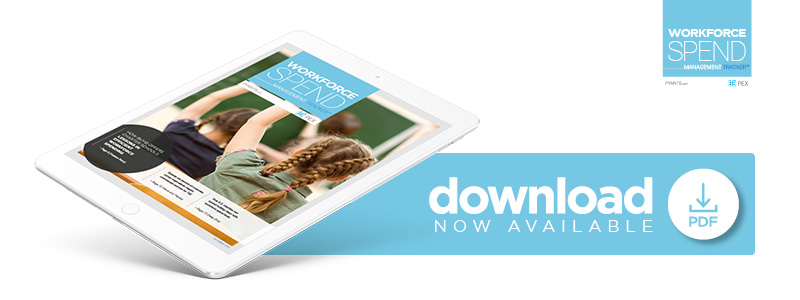For Charter Schools, A Workforce Spend Tutorial

Public charter schools operate independently from traditional public schools — but with this autonomy, says Marco Rafanelli of BuyQ, comes less purchasing power and greater spending scrutiny from local regulators. In the new Workforce Spend Management Tracker, Rafanelli explains how group purchasing solutions can help charter school administrators spend public funds efficiently while remaining transparent.
 According to the latest figures, the U.S. public school system is responsible for overseeing approximately 50 million students’ educations. Because they are funded by taxpayers, public schools must spend funds wisely and appropriately to remain transparent.
According to the latest figures, the U.S. public school system is responsible for overseeing approximately 50 million students’ educations. Because they are funded by taxpayers, public schools must spend funds wisely and appropriately to remain transparent.
This can be especially true for public charter schools. These schools are publicly funded but operate independently from traditional public schools, adhering to specific school and local or district authority guidelines. According to the National Alliance for Public Charter Schools’ latest figures, approximately 7,000 charter schools are currently educating more than 3.2 million students in 43 states and the District of Columbia.
These schools have greater autonomy than traditional public schools, but they also face more scrutiny from local regulators. Given charter schools’ requirements and expectations, it’s no wonder that some are turning to flexible workforce management solutions to help them manage spending. To better understand charter schools’ challenges, PYMNTS spoke with Marco Rafanelli, CEO and co-founder of BuyQ, a group purchasing organization that specifically caters to the charter school market.
“From a business standpoint, from an operations standpoint, [charter schools are] very independent,” Rafanelli said. “And with that independence comes independence in operations areas, such as purchasing.”
Charter School Spending Lessons
Rafanelli said BuyQ was inspired by his own experience of working with charter schools in Colorado. He learned that they often lack the collective purchasing power available to traditional public schools. The company addresses these hurdles by offering charter schools combined purchasing power, negotiating vendor discounts and providing them better value and pricing on purchases.
“We saw that there was a need across the country for charter schools to have more options — more purchasing options — and have access to better pricing, better terms and conditions on the things they are buying,” he said.
Traditional public schools usually enter contracts with specific classroom supply vendors, but charter schools often don’t have the option of negotiating on vendors or prices. Rafanelli said BuyQ, however, provides the group purchasing capabilities that charter schools need to effectively and efficiently purchase supplies.
He claimed that the solution also helps vendors navigate the “opaque” charter school market to help them connect with potential customers. Charter schools might be able to purchase needed products and services, he said, but they may be unaware of or unable to access the same discounts available to traditional schools.
BuyQ’s goal is to bring together all parties involved in charter schools’ purchasing processes. The service also offers a request for proposal (RFP) process that can help charter schools comply with relevant federal regulations.
“Hopefully, in the end, that all adds up to … more dollars to spend on mission-critical expenditures for the school,” he said.
Teaching Charter School Transparency
Rafanelli noted that the independent nature of charter schools often makes their roles similar to those of SMBs. Many charter schools have discovered, however, that independence can be a double-edged sword.
“The result of independence is [that] charter schools are somewhat on their own,” he said. “They find themselves sourcing products they need like an SMB would.”
Unlike SMBs, however, charter schools must demonstrate that they are appropriately spending public funds. They could also be required to demonstrate that they used a transparent RFP process for procurements.
“Charter schools are using public funds, and they need to be stewards of those public funds,” Rafanelli said. “So they will typically put in place their own policies that govern how they use funds.”
BuyQ’s services also help charter schools achieve transparency by ensuring all purchases are appropriate. He said the solution can, for example, ensure that charter schools adhere to the stipulations attached to grants and federal funds.
“It checks those compliance boxes and allows [charter schools] to confidently make purchases knowing the vendor and vendor’s products have been selected via a compliance-friendly process,” he said.
Rafanelli added that the service could also help staff focus on educational services, instead of back-end needs, which provides additional benefits to charter schools.
“It can reduce the administrative time [spent] and the burden around purchasing,” he explained, “by focusing on other areas of spend where contracts might not be available.”
Charter School Spending Basics
In addition to offering procurement solutions, BuyQ helps charter school staff use flexible spending cards for day-to-day purchases. Employee expense management and prepaid card platform PEX supplied the cards, which enable teachers to more effectively shop for school supplies. These cards are useful because charter school teachers might not know which purchases and vendors are approved, and any unauthorized expenses can create complications for teachers and staff.
“There’s typically not a lot of control over those expenditures,” he said. “It can breed confusion on the staff level. ‘Where should I spend my money? Is this an appropriate amount to spend?’”
Flexible payment cards, however, can help staff purchase what they need while giving administrators and accounting departments greater control and insight into how funds are spent.
“[Prepaid cards allow for] good visibility, expectation-setting and appropriate controls for those staff members,” Rafanelli said. “It just adds a whole level of control and clarity in an area that, I would say, has been quite muddy in the past.”
Charter school teachers take an independent approach to educating students about history, science, literature and mathematics, and while this independent educational model comes with its own unique spending and transparency challenges, workforce management tools could provide the tutorial educators need to pass the efficiency test.
